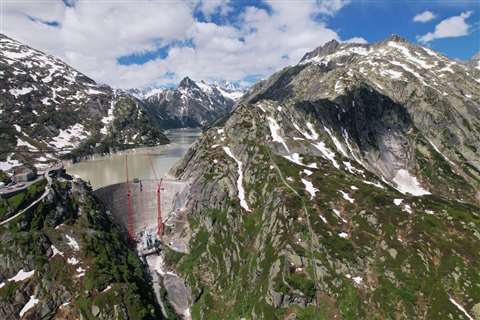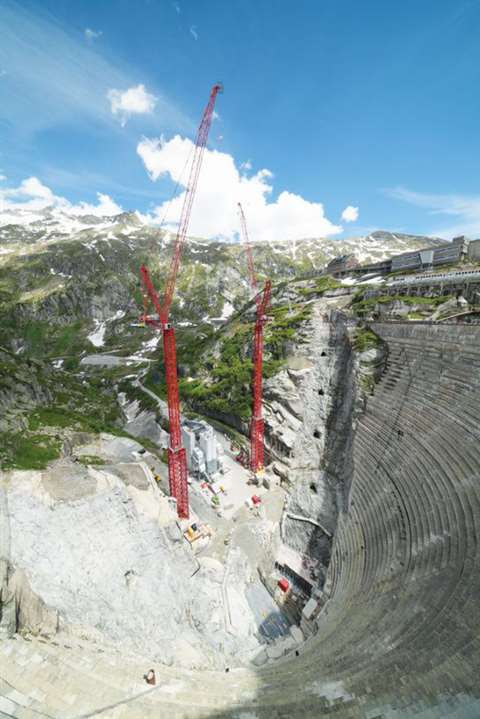How Wolff is taking giant steps to overhaul Spitallamm dam
07 September 2021
High in the Swiss Alps a pair of giant Wolff tower cranes are battling difficult terrain at lake Grimsel. Alex Dahm reports
Wolves of the furry kind reappeared in Switzerland some years ago and now two red steel Wolff tower cranes have started working on a job at Lake Grimsel.
The Wolff 1250 B luffing jib cranes are working to replace the Spitallamm dam at Lake Grimsel. June saw the two 1,250 tonne-metre giants erected in the valley at the base of the existing dam on the new 6 x 6 metre TV 60 tower system specially developed for this project. For the next four years, in all weathers, they will be working for the Kraftwerke Oberhasli AG (KWO) on behalf of the ARGE Grimsel construction consortium.
 The Wolff 1250 B luffing jib cranes are being used to replace the Spitallamm dam at Lake Grimsel in Switzerland
The Wolff 1250 B luffing jib cranes are being used to replace the Spitallamm dam at Lake Grimsel in Switzerland
The new double curvature dam will be 113 metres high and 212 metres long. It is built directly in front of the old one which will remain in place but will have big holes put in it to let the water through.
2,000 metres up
At nearly 2,000 metres above sea level the weather is a bit different. In June it was already summer in the lowlands while there was still snow at Lake Grimsel when the two big luffers were erected. A team of eight got the two cranes up with 70 and 75 metre jibs, to respective final tower heights of 92.1 and 87.1 metres, within two weeks.
Also impressive was that a dearth of space on site to store components meant the 70 truckloads of components had to arrive in the right order and just in time. Winding mountain passes to access the site made this more difficult. Erection was completed using 500 tonne and 150 tonne capacity wheeled mobile cranes.
 They will be working for the Kraftwerke Oberhasli AG (KWO) on behalf of the ARGE Grimsel construction consortium
They will be working for the Kraftwerke Oberhasli AG (KWO) on behalf of the ARGE Grimsel construction consortium
An exceptional freestanding height requirement meant a new tower section had to be developed. Fourteen pieces of the XXL TV 60 tower sections were used for the two cranes. Seven on each gave the same height of 35 metres. They were then topped with the smaller TV33 sections, ten on one and nine on the other.
The new TV 60 tower sections were erected a year ago and spent the winter under snow more than ten metres deep at times. Instead of dismantling and storing the cranes over winter they will remain erected on site for the full four year duration of the project.Many factors had to be considered to winterise the cranes and their installation. “Tie-ins on the rock massif or on the dam were neither a technical nor economical alternative,” says Rolf Mathys, Wolffkran Schweiz managing director.
“Freestanding cranes with a maximum lifting capacity of 20 tonnes in one-fall operation and a tip load capacity of 11 tonnes at a jib radius of 75 metres that have to withstand wind speeds of up to 220 km/h, avalanches and icing, were simply not feasible with the regular Wolff tower system and standard calculation for the Wolff 1250 B. Everything needed to be recalculated from scratch. On the Grimsel, we are dealing with conditions that are entirely different from those of a standard construction site,” says Mathys.
Wolff VR 3360 and other features
In addition to the new 6 metre XXL TV 60 tower section, Wolff developed the VR 3360 adaptor frame to connect the TV 60 with the 3.3 metre TV 33 tower sections. In turn, this was achieved via a further transition piece, the TV 33 S. It is a reinforced TV 33 section to go between the TV60 and the standard TV33.
Exposure to ice, snow and wind at Lake Grimsel exerts extreme loads on the structure. “Iced surfaces and what are known as ice flags on the slewing parts and towers must be factored in as additional wind surfaces,” explains Rolf Mathys.
“Furthermore, snow and ice are literally heavy and therefore statically relevant.” Specially manufactured foundation anchors and more than 600 cubic metres of concrete support each crane. It is about ten times more concrete than for an average foundation, Mathys says.
Ready for winter
Winterising includes heater pads in the slew drives to stop them from freezing. Heaters are fitted to the operator cabin and the electrical cabinet. Slew rings, hoist mechanisms and luffing ropes will all be greased before winter. An automatic rotation program will loosen icing two or three times a day.
Most of the work for the two cranes is pouring concrete – 220,000 cubic metres of it – for the new arch dam. In what will be a virtually continuous double-shift operation, each cycle takes less than seven minutes to fill the 7 cubic metre concrete skip, lift its 20 tonnes, place and return it for the next load.





